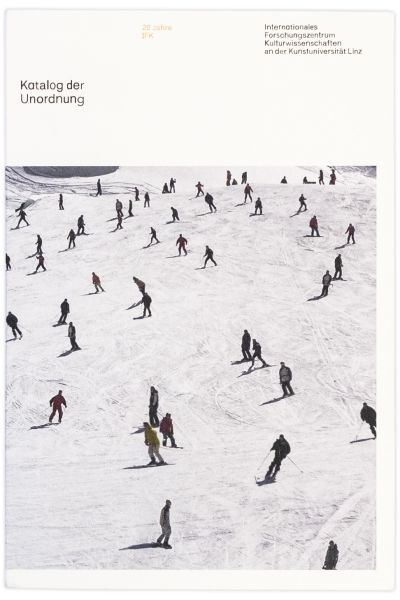Helmuth Lethen, IFK
Katalog der Unordnung 20 Jahre IFK
- Kategorie
- Silver Medal
Begründung der Jury
★★★
Austria /// Österreich
★★★
Rather than “catalogue of disorder”, as its title might be translated, this book could just as well have been called “catalogue of order”. For this it is indebted to its ironic borrowing of classic Swiss typography with which the macro-structure of this Austrian book is organised. Sans-serif typefaces, its confinement to just three font sizes, an anaxial type-area with margin, a top margin with generous white space and vibrant page headings, detailed contents pages with forewords on grey card. Yet some things are nevertheless surprising. The book’s components are constantly re-sorted in the multiple table of contents. Not until the fifth list does one reach what one would normally expect by way of summary of contents, here consistently bearing the heading: page numbers. Within the book’s interior the columns are not fixed, exchanging places with the margin as required. But what really stands out is the typeface. With hot lead typesetting it would sometimes happen that a character from another typeface would smuggle its way into the line of print. In printer’s jargon this was then known as a »printer’s pie«. Here the typesetting is made up exclusively of such printer’s pies, with eight different sans-serif typefaces being wildly jumbled together. And, surprisingly, this apogee of typographical chaos engenders a pleasantly shimmering appearance. Order or disorder is a matter of the perspective from which one regards the complexity of the given circumstances.
★★★
Dieses Buch könnte auch betitelt sein: Katalog der Ordnung. Das ist der ironischen Anleihe klassischer Schweizer Typografie zu verdanken, mit der die Makrostruktur des österreichischen Buches organisiert ist. Groteskschriften, Beschränkung auf drei Schriftgrade, anaxialer Satzspiegel mit Marginalspalte, Kopfsteg mit üppigem Weißraum und lebendem Seitentitel, ausführliches Inhaltsverzeichnis mit Vorworten auf grauem Karton. Aber dann verwundert doch Einiges. Die Bestandteile des Buches werden in dem multiplen Inhaltsverzeichnis immer wieder neu sortiert. Erst mit der fünften Liste gelangt man zum gewohnten Inhaltsverzeichnis, das hier konsequent die Überschrift trägt: Seitenzahlen. Im Buchinneren ist die Satzkolumne nicht fixiert, sie tauscht je nach Anlass mit der Marginalspalte ihren Platz. Aber der Clou ist die Schrift. Im Bleisatz geschah es damals gelegentlich, dass sich eine Letter aus einer anderen Type in die Druckzeile mogelte. Das war dann in der Druckersprache ein Zwiebelfisch. Hier besteht der komplette Satz ausschließlich aus Zwiebelfischen, acht verschiedene Grotesktypen sind wild zusammengewürfelt. Und dieser Gipfel des typografischen Chaos erzeugt überraschenderweise ein angenehm flirrendes Schriftbild. Ordnung oder Unordnung ist eine Sache der Perspektive, aus der man auf die Komplexität der Gegebenheiten blickt.



